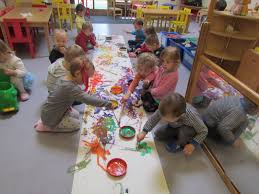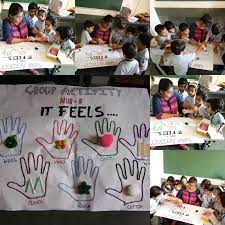In a world bustling with technology and fast-paced living, the significance of early childhood development cannot be overstated. Nursery activities play a pivotal role in fostering a child’s cognitive, social, and emotional growth. Let’s dive into the world of nursery activities, exploring their benefits, types, and effective implementation at home.
Definition of Nursery Activities
Nursery activities encompass a diverse range of experiences designed to stimulate the minds and bodies of young children. These classroom activities are geared towards enhancing the overall development of a child during their formative years.
Importance of Engaging Nursery Activities
Engaging children in fun nursery activities from a young age sets the stage for a lifetime of learning. These activities not only entertain but also lay the foundation for crucial skills and behaviors.
Benefits of Nursery Activities
Cognitive Development
Nursery activities stimulate a child’s cognitive abilities, fostering skills such as problem-solving, critical thinking, and creativity. Engaging in activities like puzzles and educational games sharpens young minds.
Social Skills Enhancement
Through group activities, children learn the importance of cooperation, sharing, and communication. These social skills are fundamental for healthy relationships in primary school and later life.
Physical Development
Active play, both indoors and outdoors, contributes to the physical development of children. It enhances motor skills, coordination, and overall physical well-being.
Emotional Well-being
Nursery activities provide a platform for emotional expression and regulation. Artistic activities, in particular, allow children to convey their feelings and build emotional resilience.
Types of Nursery Activities
Creative Arts and Crafts
Artistic expression through drawing, painting, and crafting not only sparks creativity but also helps children develop fine motor skills.
Storytelling and Reading
Immersing children in the world of stories and books nurtures a love for reading, expands vocabulary, and ignites imagination.
Music and Movement
Rhythmic activities and dance not only encourage physical activity but also enhance auditory and sensory perception.
Outdoor Play
Exploration of the outdoors contributes to a child’s understanding of the natural world, and future education and promoting curiosity and a connection with nature.
Incorporating Nursery Activities at Home
Creating a Safe and Stimulating Environment
Designating a space at home for activities and ensuring it’s safe and conducive to learning is vital.
Age-Appropriate Activities
Tailoring activities based on a child’s age ensures engagement without overwhelming them with complexity or monotony.
Involving Parents and Caregivers
The involvement of parents and caregivers in nursery activities strengthens the bond between adults and children, creating a supportive learning environment.
Addressing Perplexity in Nursery Activities
Adapting Activities for Different Ages
Tailoring activities to suit the developmental stage of the child ensures continued engagement and progression.
Tailoring Activities to Individual Interests
Recognizing and incorporating a child’s specific interests keeps activities exciting and relevant.
Balancing Structure and Freedom
Providing a balance between structured and unstructured activities fosters both discipline and creativity.
Burstiness in Nursery Activities
Introducing Surprise Elements
Incorporating unexpected elements sensory play in activities keeps children intrigued and eager to participate.
Rotating Activity Themes
Regularly changing activity themes prevents monotony, keeping children excited about what comes next.
Incorporating Seasonal and Holiday Themes
Aligning activities with seasons and holidays adds a festive and enjoyable dimension to nursery experiences.
Tips for Effective Implementation
Consistency in Routine
Establishing a consistent routine outdoor learning also provides a sense of security for children, making them more receptive to learning.
Observation and Adaptation
Careful observation of a child’s responses allows for the adaptation of activities to suit their evolving needs literacy skills and interests.
Encouraging Exploration and Curiosity
Fostering an environment at school that encourages exploration sparks curiosity and a love for learning.
Common Challenges and Solutions
Lack of Interest
If a child shows disinterest, exploring different activities and discovering their preferences can reignite enthusiasm.
Time Constraints
Incorporating short, engaging activities into daily routines helps overcome time constraints.
Limited Resources
Simple and cost-effective activities can be just as impactful, ensuring that limited resources are not a barrier to engagement.
Success Stories
Testimonials from Parents
Real-life accounts from parents showcase the positive impact of nursery activities on their children’s development.
Positive Impact on Child Development
Highlighting specific instances where nursery activities have contributed to milestones in a child’s growth.
The Future of Nursery Activities
Trends and Innovations
Exploring emerging trends and innovations in nursery activities, including technology integration and new methodologies.
Technological Integration
The role of technology in shaping the future of nursery activities and its potential benefits and challenges.
Imaginative Play
Imaginative play, also known as pretend play or make-believe, is a crucial aspect of childhood development. It involves children creating imaginary scenarios, characters, and narratives, using their creativity to explore the world around them.
Importance of Imaginative Play
Imaginative play is more than just a source of entertainment; it’s a fundamental building block for a child’s cognitive, emotional, and social development. In this article, we will delve into the enchanting world of imaginative play, exploring its benefits, various forms sand play, and how parents can encourage and participate in this magical journey.
Benefits of Imaginative Play
Cognitive Development
Imaginative play stimulates a child’s cognitive abilities by encouraging problem-solving, decision-making, and abstract thinking. When children engage in role-playing, they are exercising their brains in a fun way, that textbooks and structured activities often cannot replicate.
Social Skills Enhancement
Through imaginative play, children learn to navigate social situations, understand emotions, and practice communication skills. Whether playing house, pretending to be superheroes, or participating in make-believe tea parties, children develop confidence and a deep understanding of human interactions.
Emotional Well-being
Imaginative play provides an outlet for emotional expression. Children can use play scenarios to explore and process various emotions, helping them develop emotional intelligence self confidence and resilience.
Language Development
The creation of stories and dialogues during imaginative play contributes significantly to language development. Children learn new words, sentence structures mathematical concepts, and expand their vocabulary in a natural and enjoyable way.
Encouraging Imaginative Play at Home
Provide Open-ended Toys
Toys that can be used in multiple ways, such as building blocks, dolls, or art supplies, encourage open-ended play, allowing children to explore their creativity freely.
Create a Play-Friendly Environment
Designate an area in the home where imaginative play is encouraged. This space should be safe, free from excessive rules, and equipped with basic props to stimulate creativity water play.
Participate in Play
Parents and caregivers play a vital role in fostering imaginative play. Joining the little ones in on the play scenarios not only strengthens the parent-child bond but also sets an example for creative exploration.
Fine Motor Skills
Fine motor skills involve the coordination of small muscles, particularly those in the hands and fingers. These skills are essential for tasks that require precision and control, such as writing, buttoning a shirt, or manipulating small objects. In this article, we’ll explore the significance of fine motor skills in child development and discover engaging activities to promote their growth.
Gross Motor Skills
Gross motor skills involve the coordination of large muscle groups and the control of body movements. These skills are fundamental for activities such as walking, running, jumping, and overall physical coordination. This article explores the importance of developing gross motor skills in children, the benefits they offer, and ways to encourage their growth through engaging activities.
In conclusion, nursery activities are a cornerstone in shaping well-rounded individuals for adult world. From cognitive development to emotional well-being, the benefits are immense. By embracing a variety of activities and addressing challenges effectively, parents and caregivers can provide an enriching environment for their children’s growth.
FAQs
- Are nursery activities only for preschool-aged children? Nursery activities can be adapted for various age groups, from infants to preschoolers, tailoring the complexity and type of activities accordingly.
- How can parents overcome resistance to participating in nursery activities? Introducing activities gradually and incorporating elements of play can help overcome resistance, making the experience enjoyable for children.
- What role do outdoor activities play in nursery development? Outdoor activities contribute to physical development, sensory exploration, and a connection with nature, enriching a child’s overall development.
- Can nursery activities be integrated into homeschooling routines? Absolutely! Many nursery activities can be seamlessly integrated into homeschooling, enhancing the learning experience for children.
- How can technology be responsibly incorporated into nursery activities? Technology can be beneficial when used mindfully. Choosing age-appropriate apps and interactive tools can enhance certain aspects of nursery activities.




Recent Comments